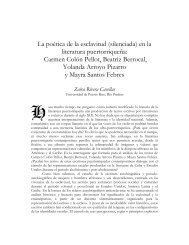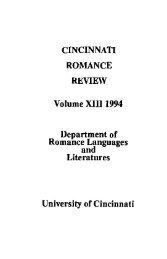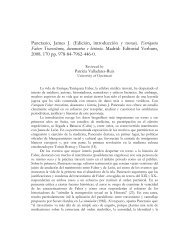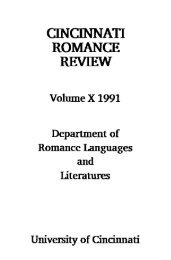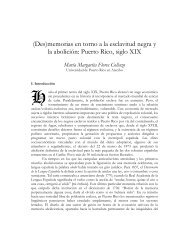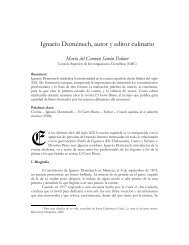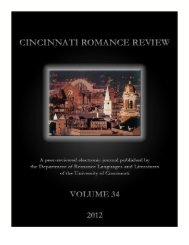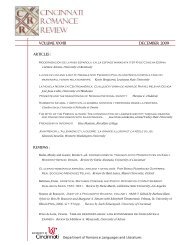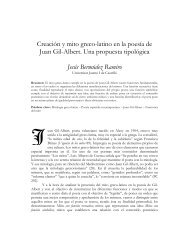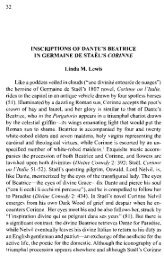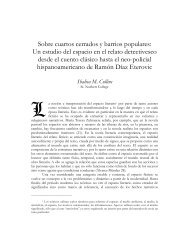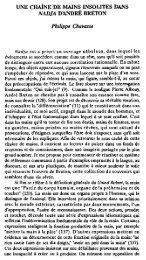Volume 30 (2011) - Cincinnati Romance Review
Volume 30 (2011) - Cincinnati Romance Review
Volume 30 (2011) - Cincinnati Romance Review
You also want an ePaper? Increase the reach of your titles
YUMPU automatically turns print PDFs into web optimized ePapers that Google loves.
76 SONJA STEPHENSON WATSON<br />
De Burgos appropriates the tropes of negrista literature in her self-portrait by<br />
describing her hair as kinky, foreign, and exotic. The subject described in the poem is<br />
an amalgam of mixed raced African descent. As a daughter of parents of German and<br />
Spanish descent, it remains unclear whether one parent or both possessed some African<br />
blood. Furthermore, de Burgos has been described as a woman “de color canela,” with<br />
“resonancias de sangre indígena” with traces of Visigothic heritage in her hair (De<br />
Burgos xxiv, xxv). Similar to her contemporary Colón Pellot, she was a light mulata.<br />
Clearly, de Burgos appropriates the negrista aesthetic to be voiced; the poem, however,<br />
stands out for its denouncement of the ills of slavery. She uses satire to poke fun at the<br />
master and to elevate her African heritage. Finally, in the last stanza, the poem evokes<br />
the theme of mulatez:<br />
Ay, ay, ay, que la raza se me fuga<br />
y hacia la raza blanca zumba y vuela<br />
a hundirse en su agua clara;<br />
o tal vez si la blanca se ensombrará en la negra.<br />
Ay, ay, ay, que mi negra raza huye<br />
y con la blanca corre a ser trigueña;<br />
¡a ser la del futuro,<br />
fraternidad de América! (32)<br />
The poem simultaneously conforms and breaks with the negrista aesthetic of the<br />
era and reinforces and defies stereotypes. Despite its acknowledgement of the evils of<br />
slavery and the white slave master, the poem terminates by dissolving racial problems<br />
on the Island through mestizaje. Notwithstanding the poem’s focus on the African<br />
heritage and the creation of a “bronzed society,” it still promotes blanqueamiento or the<br />
eventual dilution of the black African population. In this respect, her poem coincides<br />
with the writings of Carmen Colón Pellot who consistently promotes blanqueamiento as<br />
an option for the plight of the mulata.<br />
“Ay, ay, ay” is Julia de Burgos’s only poem that clearly refers to her African<br />
heritage. Although she was the “first published Puerto Rican female poet to adopt a<br />
‘mulata’ identity”, she wrote primarily as a female poet and not as a racial one (López<br />
Springfield 64). However, it was equally difficult to write as a female poet and as a racial<br />
one during an era when male writers dominated the literary sphere. The lack of<br />
reception of her works attests to this difficulty. De Burgos’s omission can further be<br />
explained by the double bind of writing as a black and female writer. As Carole Boyce<br />
Davies reminds us, “For it is the additional identity of femaleness which interferes with<br />
seamless Black identity and is therefore either ignored, erased or ‘spoken for’ (8). Julia<br />
de Burgos allowed her race to be “spoken for” in order to focus primarily on gender<br />
issues of the period. Her contemporary Colón Pellot recoups many of these feminist<br />
themes but clearly demonstrates that they are complicated by her race.<br />
<strong>Cincinnati</strong> <strong>Romance</strong> <strong>Review</strong> <strong>30</strong> (Winter <strong>2011</strong>): 69-82.



